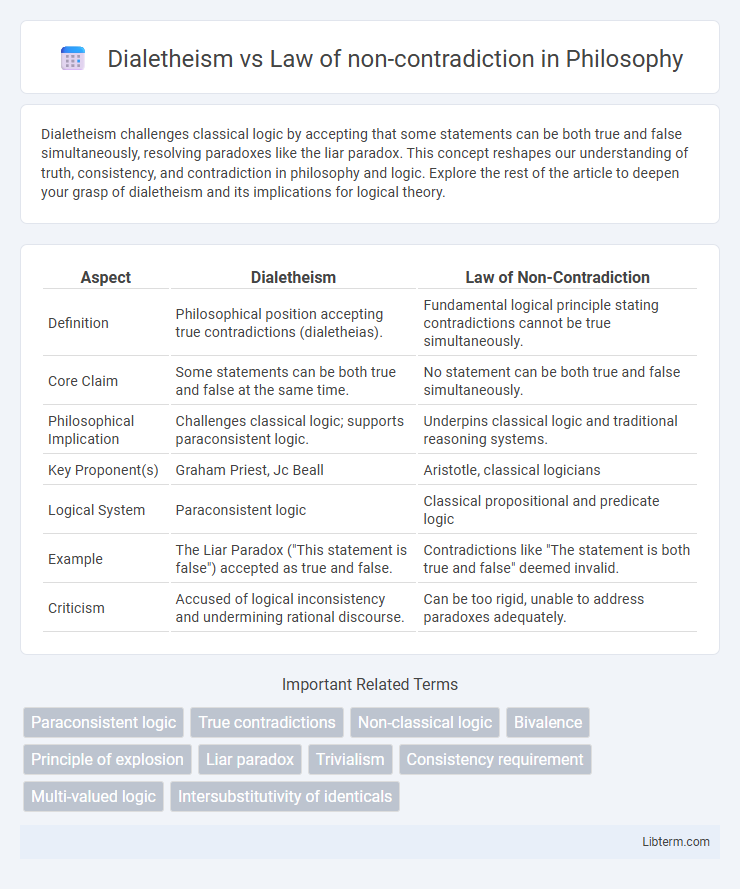Dialetheism challenges classical logic by accepting that some statements can be both true and false simultaneously, resolving paradoxes like the liar paradox. This concept reshapes our understanding of truth, consistency, and contradiction in philosophy and logic. Explore the rest of the article to deepen your grasp of dialetheism and its implications for logical theory.
Table of Comparison
| Aspect | Dialetheism | Law of Non-Contradiction |
|---|---|---|
| Definition | Philosophical position accepting true contradictions (dialetheias). | Fundamental logical principle stating contradictions cannot be true simultaneously. |
| Core Claim | Some statements can be both true and false at the same time. | No statement can be both true and false simultaneously. |
| Philosophical Implication | Challenges classical logic; supports paraconsistent logic. | Underpins classical logic and traditional reasoning systems. |
| Key Proponent(s) | Graham Priest, Jc Beall | Aristotle, classical logicians |
| Logical System | Paraconsistent logic | Classical propositional and predicate logic |
| Example | The Liar Paradox ("This statement is false") accepted as true and false. | Contradictions like "The statement is both true and false" deemed invalid. |
| Criticism | Accused of logical inconsistency and undermining rational discourse. | Can be too rigid, unable to address paradoxes adequately. |
Understanding Dialetheism
Dialetheism challenges the classical Law of Non-Contradiction by asserting that some statements can be both true and false simultaneously, thereby rejecting the principle that a proposition cannot contradict itself. This view is central to paraconsistent logic, which accommodates true contradictions without collapsing into logical chaos. Understanding dialetheism requires recognizing that it reconfigures traditional binary logic, allowing for a more nuanced interpretation of paradoxes such as the Liar Paradox.
The Law of Non-Contradiction Explained
The Law of Non-Contradiction states that a proposition cannot be both true and false simultaneously, forming the foundation of classical logic and ensuring consistency in reasoning. Dialetheism challenges this principle by asserting that some statements can be true and false at the same time, embracing genuine contradictions known as dialetheias. Understanding the Law of Non-Contradiction highlights the fundamental debate between traditional logic and dialetheism's acceptance of paradoxes.
Historical Roots of Dialetheism
Dialetheism, which asserts that some contradictions can be true, traces its historical roots to ancient Eastern philosophies, such as Jainism and certain strands of Buddhism that embraced paradoxes in logic. These traditions challenged the classical Law of Non-Contradiction, a principle formalized by Aristotle, stating that contradictory statements cannot both be true simultaneously. The revival of dialetheism in contemporary logic is largely attributed to philosophers like Graham Priest, who drew from both ancient sources and modern paraconsistent logic to question the universality of classical logical laws.
Classical Logic and Its Constraints
Classical logic is fundamentally grounded in the Law of Non-Contradiction, which asserts that a statement and its negation cannot both be true simultaneously. Dialetheism challenges this foundational principle by allowing for true contradictions, known as dialetheias, thereby expanding the boundaries of logical frameworks. The constraints of classical logic, including bivalence and consistency, are critically re-evaluated in dialetheist theories to accommodate paradoxical statements like the Liar Paradox.
Key Philosophers in the Debate
Dialetheism challenges the Law of Non-Contradiction by asserting that some statements can be both true and false simultaneously, a view prominently advocated by philosopher Graham Priest. Aristotle, often credited with formulating the classical Law of Non-Contradiction, argued that contradictory propositions cannot both be true at the same time. Philosophers like Jc Beall and Michael Glanzberg have further developed dialetheist theories, emphasizing the logical necessity to accommodate true contradictions in certain paradoxical contexts.
Arguments Supporting Dialetheism
Dialetheism challenges the Law of Non-Contradiction by arguing that some statements can be both true and false simultaneously, supported by examples in semantic paradoxes like the Liar Paradox and certain phenomena in quantum mechanics. The principle gains traction through dialetheic logic systems, which allow for true contradictions without collapsing into triviality, offering robust frameworks for handling paradoxical and inconsistent information. This approach provides an innovative solution to classical logical dilemmas by formally embracing and analyzing contradictions rather than rejecting them outright.
Criticisms of Dialetheism
Dialetheism challenges the Law of Non-Contradiction by asserting that some contradictions can be true, provoking significant criticism for undermining classical logic's foundations. Critics argue that dialetheism leads to trivialism, where any statement could be proven true, thus collapsing meaningful logical distinction. Furthermore, opponents contend that dialetheism fails to provide a clear, consistent framework to manage contradictory information without logical chaos.
Dialetheism in Modern Logic
Dialetheism in modern logic challenges the traditional Law of Non-Contradiction by accepting that some statements can be both true and false simultaneously, particularly in contexts involving paradoxes such as the Liar Paradox. This approach has influenced developments in paraconsistent logic, allowing systems to handle contradictions without collapsing into triviality. Philosophers like Graham Priest have been instrumental in formalizing dialetheism, which reshapes foundational principles of classical logic by relaxing the strict binary constraints on truth values.
Implications for Philosophy and Science
Dialetheism challenges the traditional Law of Non-Contradiction by allowing some statements to be both true and false simultaneously, impacting foundational principles in logic and epistemology. This perspective forces a reevaluation of classical binary logic systems used in scientific theories, potentially leading to more flexible models that account for paradoxes and inconsistencies. Philosophically, dialetheism prompts new approaches to truth, knowledge, and reality by embracing contradictions rather than resolving or excluding them.
Future Directions in the Paradox Discourse
Dialetheism, which accepts true contradictions, challenges the classical Law of Non-Contradiction foundational to traditional logic systems. Future research in the paradox discourse is likely to explore hybrid logical frameworks that integrate dialetheic principles with non-contradictory logic to address phenomena such as semantic paradoxes and quantum superpositions. Advances in computational logic and formal semantics may also drive novel approaches to reconcile or accommodate contradictions without collapsing consistency in both philosophical and artificial intelligence contexts.
Dialetheism Infographic

 libterm.com
libterm.com